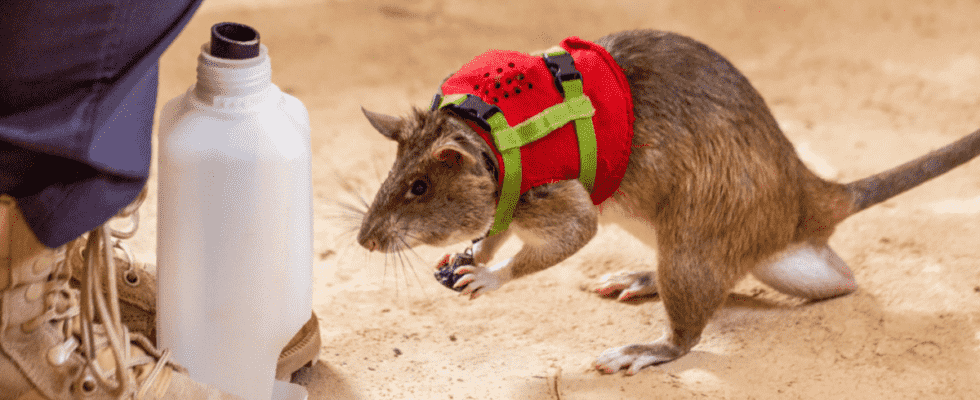People are hard to find in ruins. After an earthquake, for example, rescue teams often use specially trained search dogs to track down missing people under the rubble. The dogs can perceive smells more finely than humans. They bark when they find someone. However, even dogs cannot penetrate all areas. Therefore, search teams could in the future be expanded to include an animal unit, which, according to the proverb, is actually the first to leave the sinking ship – rats, of all things.
The non-profit Belgian NGO APOPO, based in Tanzania, has been successfully using so-called giant hamster rats for years to search for hidden landmines in former war zones. Unlike metal detectors, rats ignore all scrap metal and only sniff out the explosives, which is why they work faster and more efficiently than humans with their machine detectors.
The so-called ‘HeroRATs “have already given many communities back secured land for agricultural development. APOPO also trains the rats to smell out tuberculosis. It is the same principle as with landmines: the rats are designed to smell specific molecules that indicate the presence of the tuberculosis pathogen. Tracking down buried people is now the third area of application of the HeroRATs.
The rats have an amazing sense of smell. As in other living beings, your olfactory cells in the nasal cavity also detect fragrances in the air you breathe and generate electrical signals that the brain uses to perceive smells. Smelling cells are so-called olfactory receptor neurons – they have fine sensory hairs with a diameter of around 0.0001 millimeters. Human hair is about 0.04 to 0.12 millimeters in diameter. There are special receptor proteins in the membrane of the hairs. Fragrances bind to these receptors. This activates the cell, which ultimately leads to the electrical signal. Humans have 380 such proteins, dogs have 900. A rat has over 1,200.
Rats are trainable like dogs
In search and rescue, dogs do not break into debris, they just sniff around the outside. Rats, on the other hand, are small and can penetrate even thick rubble. They have another advantage: They are just as trainable as dogs, but not tied to their trainer. For rats, it doesn’t matter who they work for.

To train the rats, the trainers take it step-by-step. First, the animals learn to return to their starting point. The trainers let the rat roam free in an empty room. As soon as the animals hear a beep, they should run to the trainer. There they are given rat pellets in powder form from a syringe as a reward, mixed with avocado and banana. In the second step, the animals use a backpack with a rubber ball. The ball is connected to a microswitch that emits the beep. The idea is simple: the rats should learn to pull on the rubber ball as soon as they track down a person. The signal sounds and the rat returns with it to the rescue workers. They now know that the search was successful. On average, it takes the rats about 30 training sessions to learn this sequence.
“We assume they can run anywhere from 10 to 20 meters on average, a maximum of about 30 meters, so we can cover a large area,” Donna Kean, a trainer at APOPO, told Science. The rats’ rucksacks will also be equipped with a microphone, light and a camera. In order to relieve people of the fear of the approaching rats, a recording should come out of the backpack that says something like: “I am a rescue rat and come to help you”.
Award for mine search rats
The individual rats differ in their personality and in their abilities. Some learn faster than others. “But I know from my experience with animals that they can always surprise you,” says Kean. “Those who don’t do the sequence so well can suddenly be among the best in their class.”
One of the best mine search rats has already received an award for its work: HeroRAT Magawa has found 39 land mines and 28 unexploded explosive devices. Within four years, she has helped clear over 141,000 square meters of land (around twenty soccer fields) so that local people can move around on their land again without fear.
Magawa was officially awarded a rat-sized gold medal by the British animal welfare organization People’s Dispensary for Sick Animals (PDSA) – the animal equivalent of the George’s Cross, which is bestowed on brave people in Great Britain. It is the first rat to receive a PDSA medal. Previous winners were brave dogs.


(jle)

